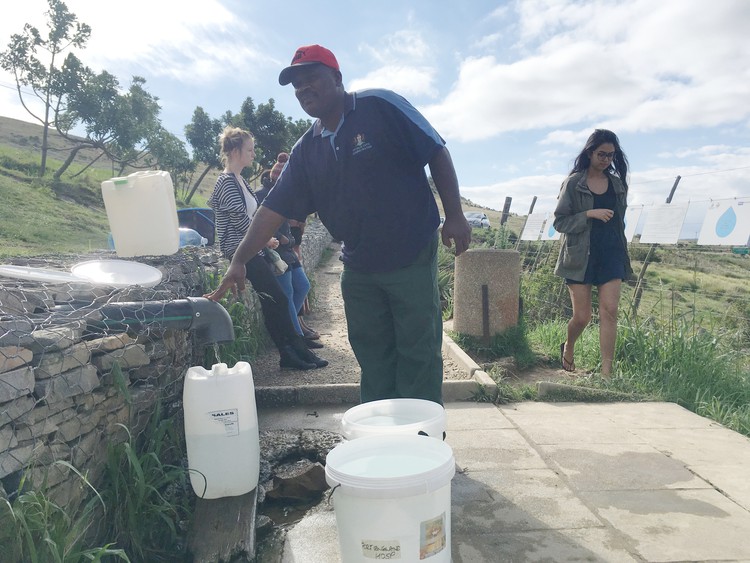Grahamstown residents queue for hours for water
Ageing infrastructure and drought blamed
Makhanda (formerly Grahamstown) is having the worst water crisis in its history. Extended drought in parts of the Eastern Cape, combined with municipal neglect of water supply infrastructure, has created a situation that may become a major health and sanitation crisis.
Parts of Makhanda East, where the townships are located, have been without running water for up to nine days, causing outrage among residents. According to the Makana Municipality, water on the eastern side of town started being restored on Wednesday, with the pumps working at 50% capacity. But some areas are still without water.
A group of protestors, many from the Unemployed People’s Movement, marched to the City Hall on Wednesday. They set trash on fire in protest against the water outages and the long-standing issue of access to clean water.
“We haven’t had water for maybe five days, and when there is, the water is brown. We do not want to use it,” said Ntomboxolo Ngeleza, one of the protestors, who lives in Tantyi Location in Makhanda East.
Ngeleza said that the municipality has not been communicating with township residents about when the water will be turned off or on, or where trucks will distribute water.
On Tuesday and Wednesday, disaster relief organisation Gift of the Givers arrived in Makhanda with trucks filled with water. The organisation sent trucks to collection points across the town. Gift of the Givers also began looking for areas to drill boreholes.
Failing infrastructure
Water is supplied to Makhanda through two treatment works: the Waainek Treatment Works and the James Kleynhans Water Treatment Works. Waainek supplies water to the west, the wealthier side of town. It receives water from the Settlers and Howiesons Poort dams, which are at 11% and 21% capacity, estimated to last until the end of the month depending on rainfall. When they run out, the Waainek Treatment Works will shut down, and the town will rely entirely on 10 megalitres a day from the James Kleynhans treatment works.
The James Kleynhans Water Treatment Works supplies water to Makhanda east, the poorer side of town. It diverts water from the Orange and Fish rivers. The problem with the James Kleynhans water treatment works is less about access to water, and more about ageing infrastructure and failed contracts.
According to the municipality, the recent water shutoff of Makhanda East was the result of a high concentration of mud in the water flowing into the treatment works, which meant the water could not be pumped. The municipality announced that they had to turn off the pumps, wait for the sludge to settle, and install a new pump before starting to turn the water back on, which it finished doing on Wednesday.
A project to upgrade the pumping capacity, from 10 to 20 megalitres per day was announced in 2015, with the project due to be completed by 2017.
Philip Machanick, Chair of the Grahamstown Residents’ Association, said that the project should have doubled the capacity for James Kleynhans. “Then the date was pushed out a year, and then the project just fell over,” he said. “If the project had been completed we wouldn’t have a problem. We could have shared that water [from James Kleynhans] and at worst we would have had mild water restrictions.”
Anele Mjekula, a spokesperson for the municipality, said that R160 million had been made available to upgrade James Kleynhans pumping capacity, from 10 to 20 megalitres a day. It is due to be completed by 2020.
He also said that the municipality is sending water tankers to areas that are still without water.
Many residents who can’t afford rainwater tanks or store-bought water (which costs R1 a litre) turn to the local spring just outside Makhanda for drinking water. Sometimes people wait for hours to get their turn to fill a container with water.
Sandile Totman Kehle works at Fort England Psychiatric Hospital in Makhanda. He says that he had no water for over a week, and when it finally did start coming back on Wednesday, he could only use it to flush toilets because of how dirty it was. Sandile gets all his drinking water from the local spring.
“This spring is our god-giver,” he said.
Rhodes University released a statement on 11 February saying that the institution is not about to shutdown, and that it is working alongside the municipality to keep the water running.
Support independent journalism
Donate using Payfast

Letters
Dear Editor
The general public and esp those who have an affection for the current government must think and reflect very carefully why this disaster has arisen. Mother nature is unpredictable and those in the public service functions should have foreseen the situation arising years ago.
Maladministration and ignorance are the primary causes of current circumstances combined together with incompetence and incapable leadership. Until that matter is addressed and corrected and political bias is eradicated the city of saints is doomed. Dysfunctional doesn't describe the seriousness of the situation and the holders of public office would be wise to anticipate public outrage directed at individuals deemed to be accountable. I pray for everyone's hope and future!
© 2019 GroundUp.
This article is licensed under a Creative Commons Attribution-NoDerivatives 4.0 International License.
You may republish this article, so long as you credit the authors and GroundUp, and do not change the text. Please include a link back to the original article.

